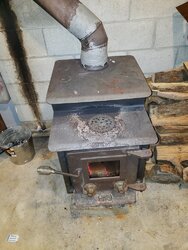Basement heater myself, (raised ranch style house, about 1600 sq ft of heating area) So about code and holes going into the upstairs floors, if you have another central heating / water heating device that uses either gas or oil you need to have some sort of isolation from them, usually a wall with a door to access serviceable equipment, in smaller homes, usually these appliances are located in the basement and the basement is sealed off from the rest of the house via door at top of the stairs; this is not requires for a fireplace, woodstove, pellet stove or any other type of solid fuel heater.
My setup is a cold air return that was boxed into the wall opposite from my stairs going into the basement since the stairs entrance is opposite from the best flow, I also cut a floor register in line with the empty ceiling chase above the wood stove, I installed a register boot (6" round) with a 6" round in-line duct fan that move approx 120cfm of air. Between the uninsulated floors, a path for the cold air to return to the basement and the ducted fan my upstairs living space stays between 68 on the coldest of cold (single digits) and will like yesterday raise up to 76deg when the outside temp is in the mid 30's. For warmer weather I just keep the stove on a low setting, dont use the stove blower or register blower.
The duct fan is a newer addition, my basement was getting way to warm for my liking (upper 80's) the fan pulls that heat and dumps it upstairs into the kitchen / dinning room area, it has helped a lot for my smaller space.


